

As the capital of Okinawa Prefecture, it is the political, economic, and cultural center. Located on the Shuri Plateau and gently sloping toward the East China Sea, the city has historically been a hub for international exchange and the flourishing culture of the Ryukyu Kingdom
Video by Naha City Tourism Association, © Naha City Tourism Association.
Around 40 minutes by car from Naha Airport, the city is surrounded by lush nature. Kudaka Island, part of the city, is revered as the "Island of the Gods" and the birthplace of the Ryukyu people. Notable sites include Sefa-utaki and Okinawa World
Video by Nanjo City, © Nanjo City.
International resort with easy access to mainland tourist spots, Chatan Town boasts a western coastline reminiscent of the American West Coast. It's renowned for attractions like the American Village entertainment complex and picturesque beaches such as Sunset Beach
Video by Chatan Town, © Chatan Town.
Yomitan Village is famous as Japan's most populous village, renowned for attractions like Cape Zanpa with its view of the Kerama Islands and Zakimi Castle ruins, offering a blend of history and natural beauty. Additionally, it's known for its pottery
Video by Yomitan Kankou Kyoukai, © Yomitan Kankou Kyoukai.
About 50 minutes by car from Naha Airport and 1 hour from the Churaumi Aquarium, Onna Village enjoys a convenient location. Along its coast, luxury accommodations are nestled, with attractions such as the Blue Cave at Cape Maeda and the scenic Manzamo
Video by Onna Village Tourism Association, © Onna Village Tourism Association.
Boasts a picturesque landscape with Mount Yae's cherry blossoms, conical karst mountains, and renowned beaches like Minna and Sesoko. Home to attractions such as the Okinawa Churaumi Aquarium and Tropical Dream Center, it offers beautiful beaches and natural wonders
Video by Motobu Town, © Motobu Town.
Nakijin Village, situated in the northern part of Okinawa Island known as "Yanbaru," is renowned for its historic Nakijin Castle Ruins, a UNESCO World Heritage Site. It's also famous for its cherry blossoms
Video by Nakijin Tourism Association, © Nakijin Tourism Association.
Nago City, located in northern Okinawa Island, features a stunning coastline with beautiful beaches and various tourist attractions, including Neo Park Okinawa and Nago Pineapple Park. It also hosted the G8 Summit in 2000 and is home to the Camp Schwab U.S. military base
Video by Nago City, © Nago City.
Known as the "Island of Beauty" since the prosperous trading days of the Ryukyu Kingdom, Kume Island boasts picturesque spots like "Hatenohama" with its white sand and "Ara Beach" famous for stunning sunsets, offering opportunities to enjoy the marine blue sea
Video by Kumejima Town Tourism Association, © Kumejima Town Tourism Association.
Most of the island is mountainous, with steep cliffs on the northern coast and sandy beaches fringed with coral reefs on the southern coast. The sea boasts world-renowned transparency and coral reefs, creating exquisite contrasts
Video by Zamami Village Tourism Association, © Zamami Village Tourism Association.
Formed by uplifted coral reefs, Miyako Island boasts a flat and featureless terrain. With no mountains or rivers, sediment does not cloud the sea, resulting in crystal-clear blue waters. The popularity of the Miyako Island Triathlon as an international event adds to the island's appeal
Video by Miyako Island Tourism Association Youth Group, © Miyako Island Tourism Association Youth Group.
Ishigaki Island lies approximately 400 kilometers southwest of Okinawa Island. Renowned for its warm climate and pristine waters, it's a renowned global diving destination. Ishigaki City, Japan's southernmost and westernmost city, serves as the resort hub of the Yaeyama Islands
Video by Ishigaki City, © Ishigaki City.
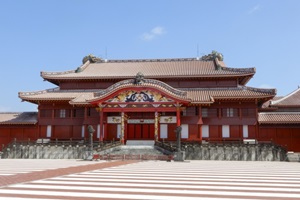
Shuri Castle's history is closely intertwined with the Ryukyu Kingdom. Constructed in the 15th and 16th centuries, its design embodies influences from both Chinese and Japanese architecture. Following the king's exile in 1879 (Meiji 12), ongoing restoration efforts have been dedicated to preserving its legacy as a UNESCO World Heritage Site
View on Google Maps
Tamaudun Royal Mausoleum, erected in 1501 by King Sho Shin of the Ryukyu Kingdom to relocate his father's remains, later served as the tomb of the Second Sho Dynasty. With three chambers, it mimics a palace with a board roofing. Recognized in 2000 as part of the "Gusuku Sites and Related Properties of the Kingdom of Ryukyu," it became a UNESCO World Heritage Site
View on Google MapsNationwide rarity, this establishment merges a museum and art gallery. Founded in 2007, it builds on its historical roots, presenting diverse fields and hosting related events. The gallery showcases modern and contemporary art reflecting Okinawa's culture
Video by Okinawa Prefectural Museum & Art Museum, © Okinawa Prefectural Museum & Art Museum.
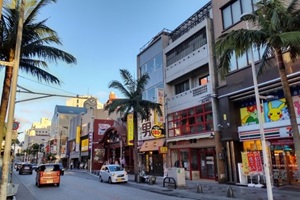
Located in Okinawa's capital, Kokusai Dori is adjacent to administrative and commercial hubs. With around 600 establishments, it offers a vibrant mix of department stores, restaurants, services, and souvenir shops
View on Google MapsOpened in 2015 near Naha Airport, this resort on Senagajima's western coast offers unique dining, shopping, and entertainment experiences, blending Okinawan charm with stunning ocean views
Video by Umikaji Terrace, © Umikaji Terrace.
Showcasing Okinawa's history, culture, and nature. Discovered in 1967 by Ehime University's expedition during American rule, Gyokusendo Cave opened to the public in 1972. Expanded over the years, it was revamped as Okinawa World in 1996, now a vital tourist destination
Video by Okinawa World, © Okinawa World.

"Utaki" refers to sacred sites widely found in the Southwest Islands, and Sefa-utaki is the highest sacred site in the Ryukyu Kingdom, appearing in its creation legend. Registered in 2000 as part of the "Gusuku Sites and Related Properties of the Kingdom of Ryukyu," it is one of the nine heritage sites
View on Google MapsIn 2000, Nakagusuku Castle Ruins were designated as a UNESCO World Heritage Site. Perched atop a 160-meter hill along the eastern coast of Okinawa Island, the castle, constructed in a near-straight line from northeast to southwest, remains intact, having largely escaped damage during World War II
Video by Nakagusuku Village Tourism Association, © Nakagusuku Village Tourism Association.
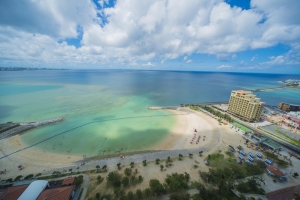
Top sunset spot in the prefecture, offering blissful moments overlooking the blue sea and white sandy beach. Adjacent to Mihama American Village, it's popular among families, couples, and locals of all ages for beach fun
Photo by Sunset Beach, © Sunset Beach.
Resort town brimming with exotic atmosphere. The entire town is unified by an American vibe, filled with colorful buildings and cute wall art, making it a photogenic area packed with photo spots
Video by American Village, © American Village.
Zakimi Castle, built around 1420 by General Gosamaru during the "Sanzan Period," helped stabilize the Ryukyu Kingdom. Despite its size, its stone walls and gates are renowned in Okinawa. Designated a UNESCO World Heritage site in 2000
Video by Yomitan Kankou Kyoukai, © Yomitan Kankou Kyoukai.
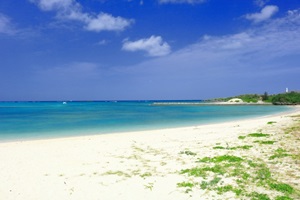
Located adjacent to the "Royal Hotel Okinawa Zanpa Misaki," this beach provides picturesque views of Zanpa Cape. Shielded by a large reef from heavy waves, it's suitable for children. It's about a 70-minute drive from Naha Airport
View on Google MapsHome to Amawari, who enriched Katsuren through trade in the 15th century. UNESCO site since 2000. Its fortress walls on natural cliffs exude elegance, offering stunning views of the Pacific, making it a top Okinawan attraction
Video by Uruma City, © Uruma City.
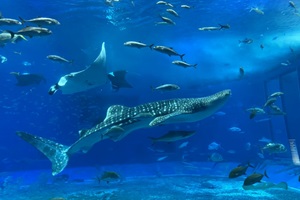
Replicates Okinawa's seas up to 700 meters deep, maintaining natural conditions. Visitors can experience a simulated journey from the coastline to the deep sea, learning about Okinawa's marine beauty and significance
View on Google Maps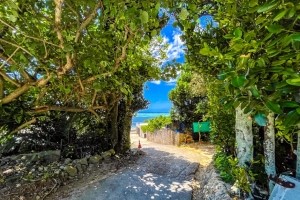
Bise village boasts a 1-kilometer tree-lined road with thousands of Fukugi trees planted since the Ryukyu Kingdom era. Fukugi, a tropical evergreen, has dense foliage, making it a traditional choice for street trees and windbreaks in Okinawa
View on Google MapsNakijin Castle was the King of Sanhoku's residence during the "Three Kingdoms Period" and later housed Ryukyu officials. Its seven enclosures feature beautifully curved stone walls. In 2000, it became a UNESCO World Heritage site as part of the "Gusuku Sites and Related Properties of the Kingdom of Ryukyu
Video by Nakijin Castle Ruins, © Nakijin Castle Ruins.
Opened in 2025 in northern Okinawa, JUNGLIA is a new resort theme park blending jungle scenery with adventure and relaxation. Attractions include a dinosaur safari, sky rides, and a giant infinity spa bath, along with evening shows featuring music and fireworks
Video by JUNGLIA OKINAWA, © JUNGLIA OKINAWA.
Standing 82 meters above sea level, this white observation tower offers stunning views of the Kouri Bridge and the vibrant Kouri blue waters. A cart ride through subtropical gardens takes you to the tower, where you can enjoy the scenery and sea breeze while taking photos
Video by Kouri Ocean Tower, © Kouri Ocean Tower.
Okinawa's cuisine is well-known for its extensive use of pork, influenced by its history as the Ryukyu Kingdom, favorable climate for pig farming, cultural significance of pork, nutritional benefits, and American culture post-World War II. Famous dishes such as rafute (braised pork belly), soki (stewed spare ribs), and mimiga (pig's ear salad) highlight pork's central role, leading to the numerous pork menus in the region today.
While many countries preserve diverse regional cuisines, Japan also offers its unique culinary journey. This video highlights select dishes, showcasing distinct local specialties and historical influences in the region
Video by Ministry of Agriculture, Forestry and Fisheries, © Ministry of Agriculture, Forestry and Fisheries.
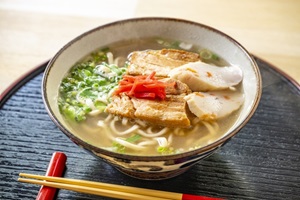
The origin is said to be the offering to the forty-ninth day memorial service of the Ryukyu king in 1534. The traditional style features clear, flavorful broth made from pork bones and bonito, topped with pork belly, ginger, fish cake, and green onions
Bitter melon stir-fry, a staple of Okinawan cuisine known for its health benefits and distinctive bitter taste
Video by Ministry of Agriculture, Forestry and Fisheries, © Ministry of Agriculture, Forestry and Fisheries.
Japan’s oldest spirits, Awamori, introduced from Siam (Thailand) in the late 14th to 15th centuries. Made from Thai rice and black koji mold native to Okinawa, it undergoes single distillation. "Ryukyu Awamori" is designated under a geographical indication system, known for its unique aroma and rich flavor
Video by Kamimura Brewery, © Kamimura Brewery.
Okinawa Prefecture, Japan’s southernmost region, is known for its unique culture, tropical landscapes, and vibrant marine life. Its capital, Naha City, anchors a region once ruled by the Ryukyu Kingdom, which was annexed by Japan in 1879. Okinawa features UNESCO sites, colorful festivals, traditional crafts, and the enduring spirit of Yuimāru—community support. Despite having no railway service aside from Naha’s Yui Rail, the region remains well-connected by buses, offering easy access for visitors.
Video by Okinawa Convention & Visitors Bureau, © Okinawa Convention & Visitors Bureau.